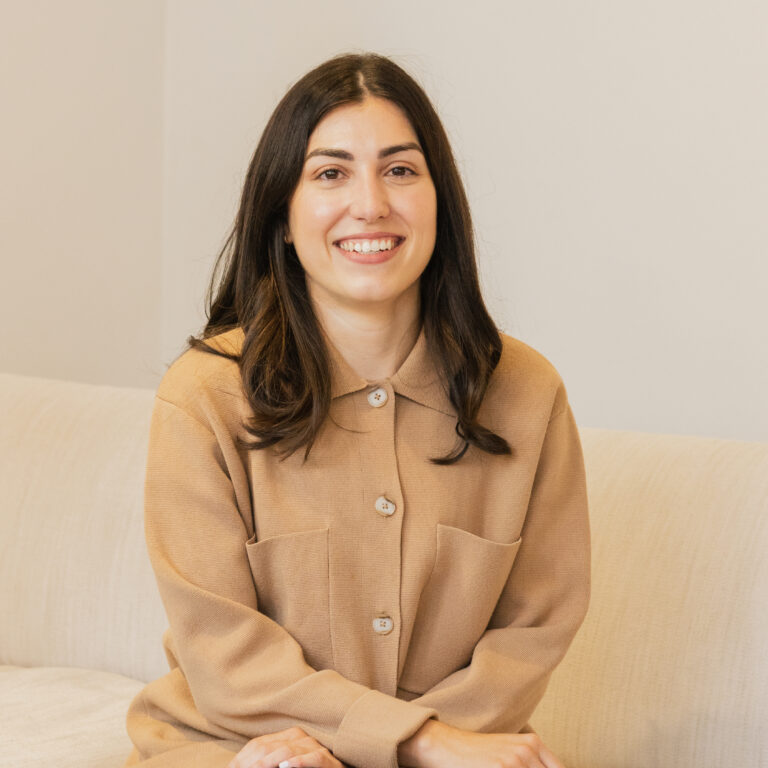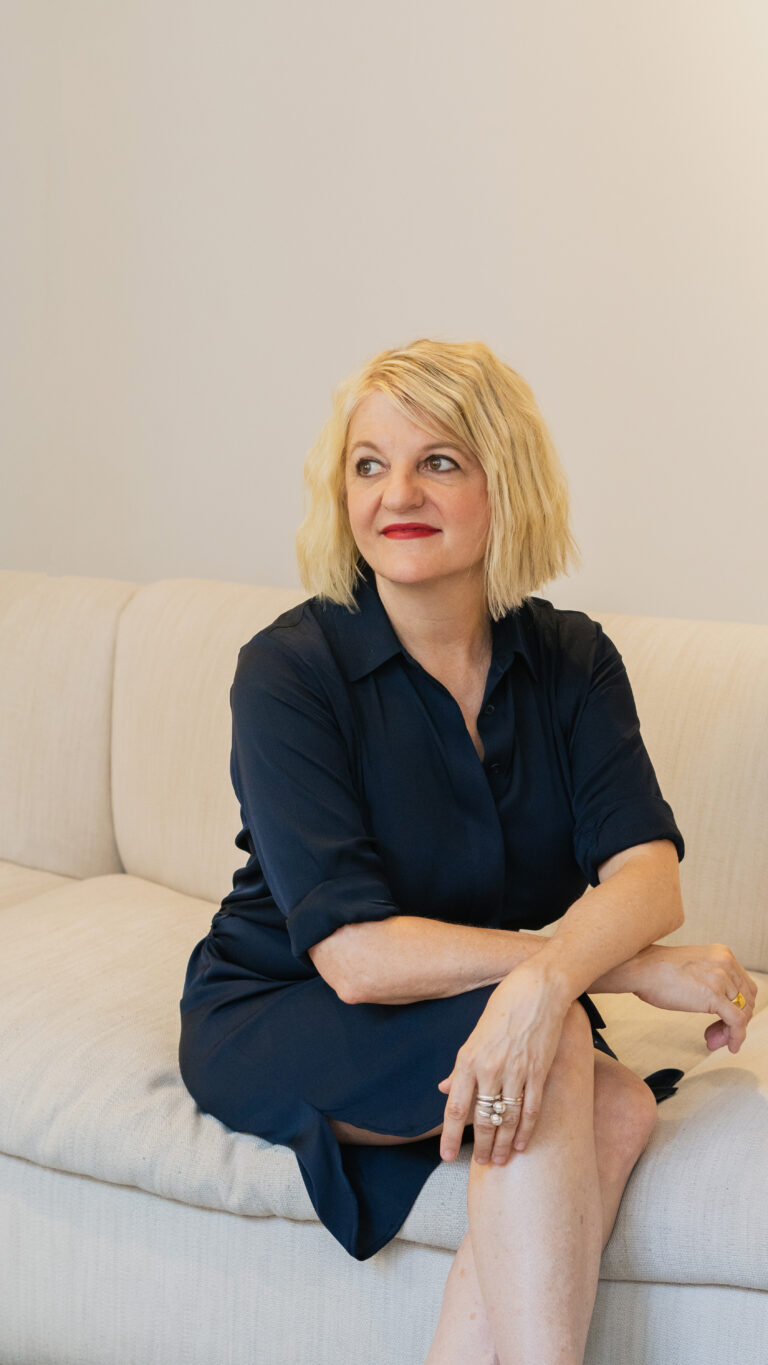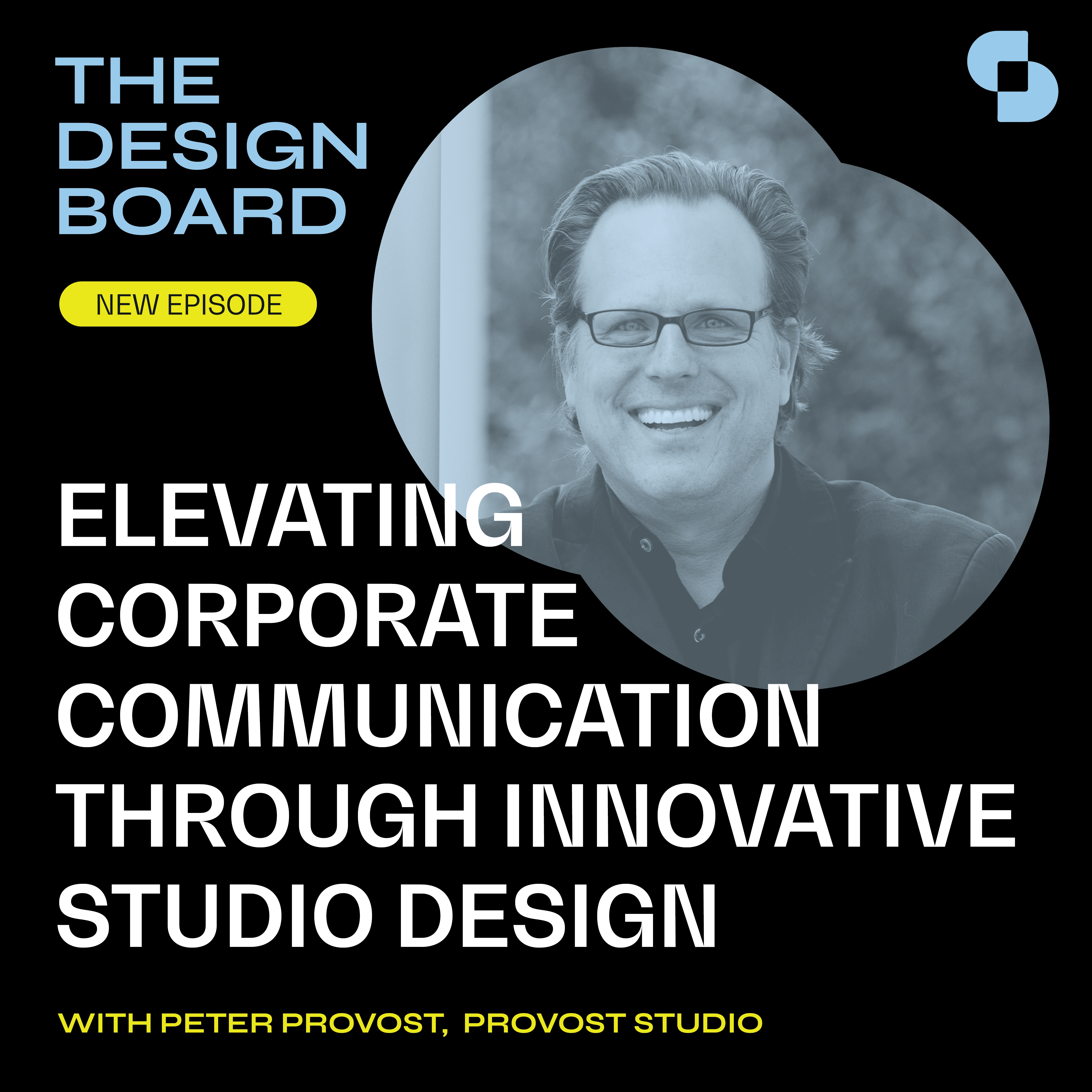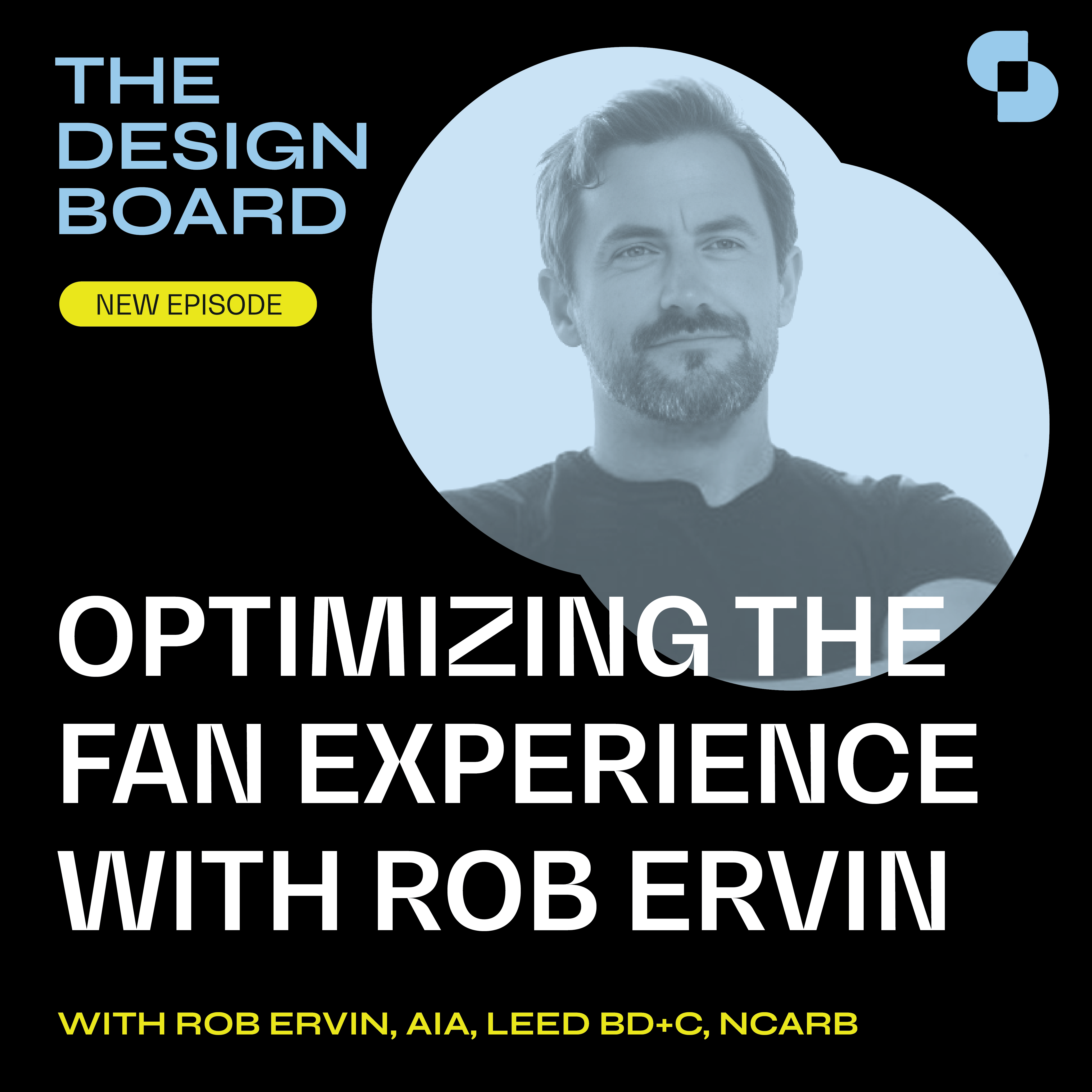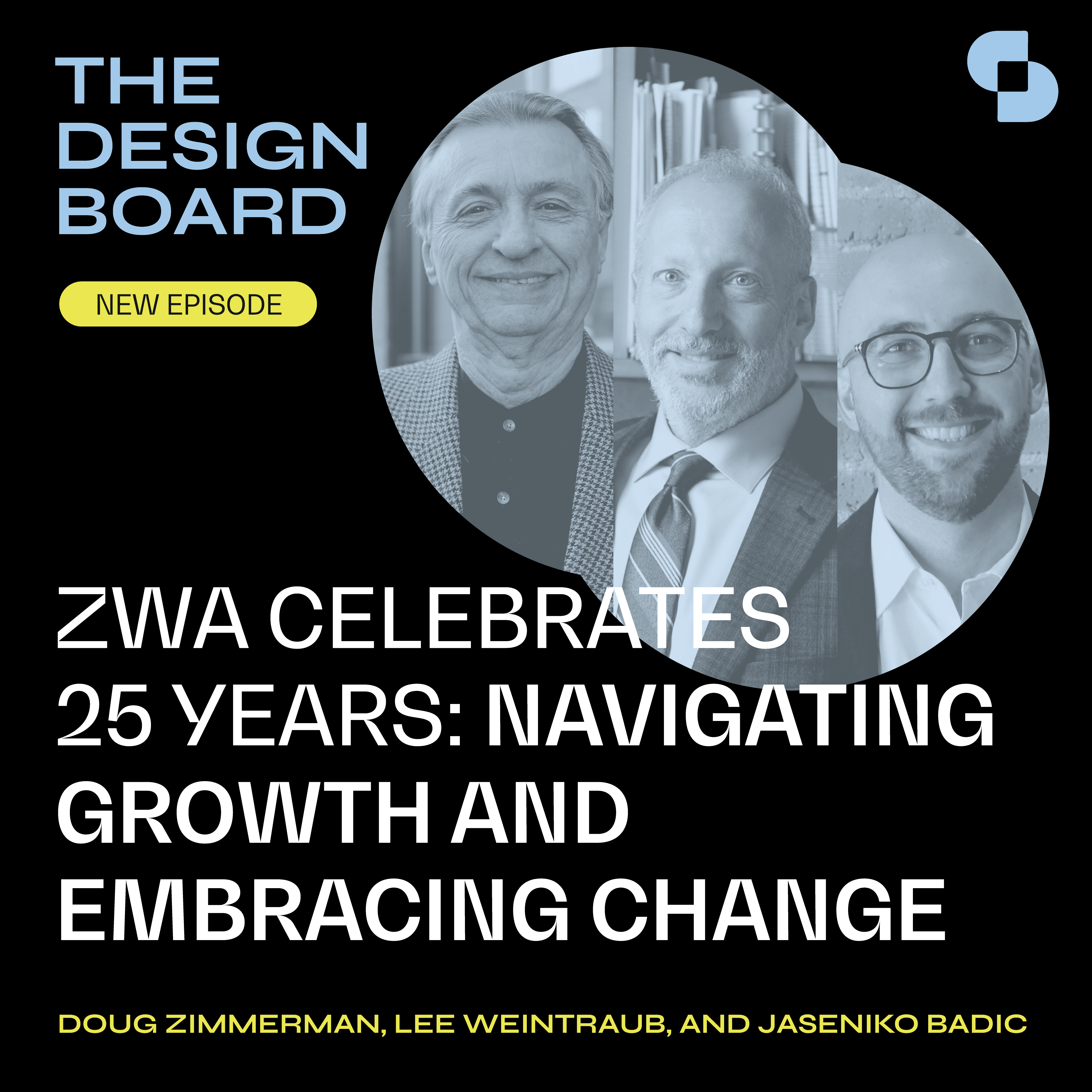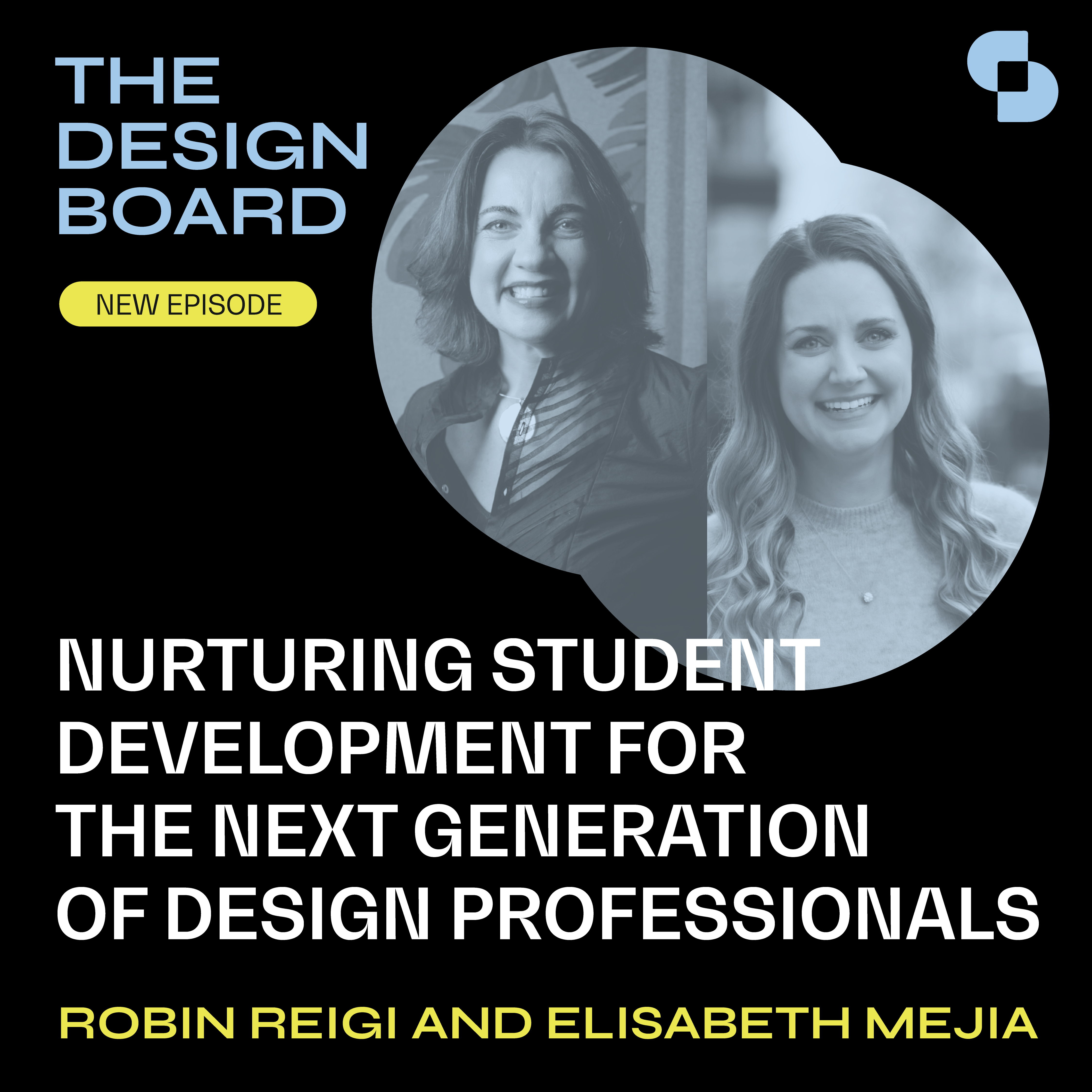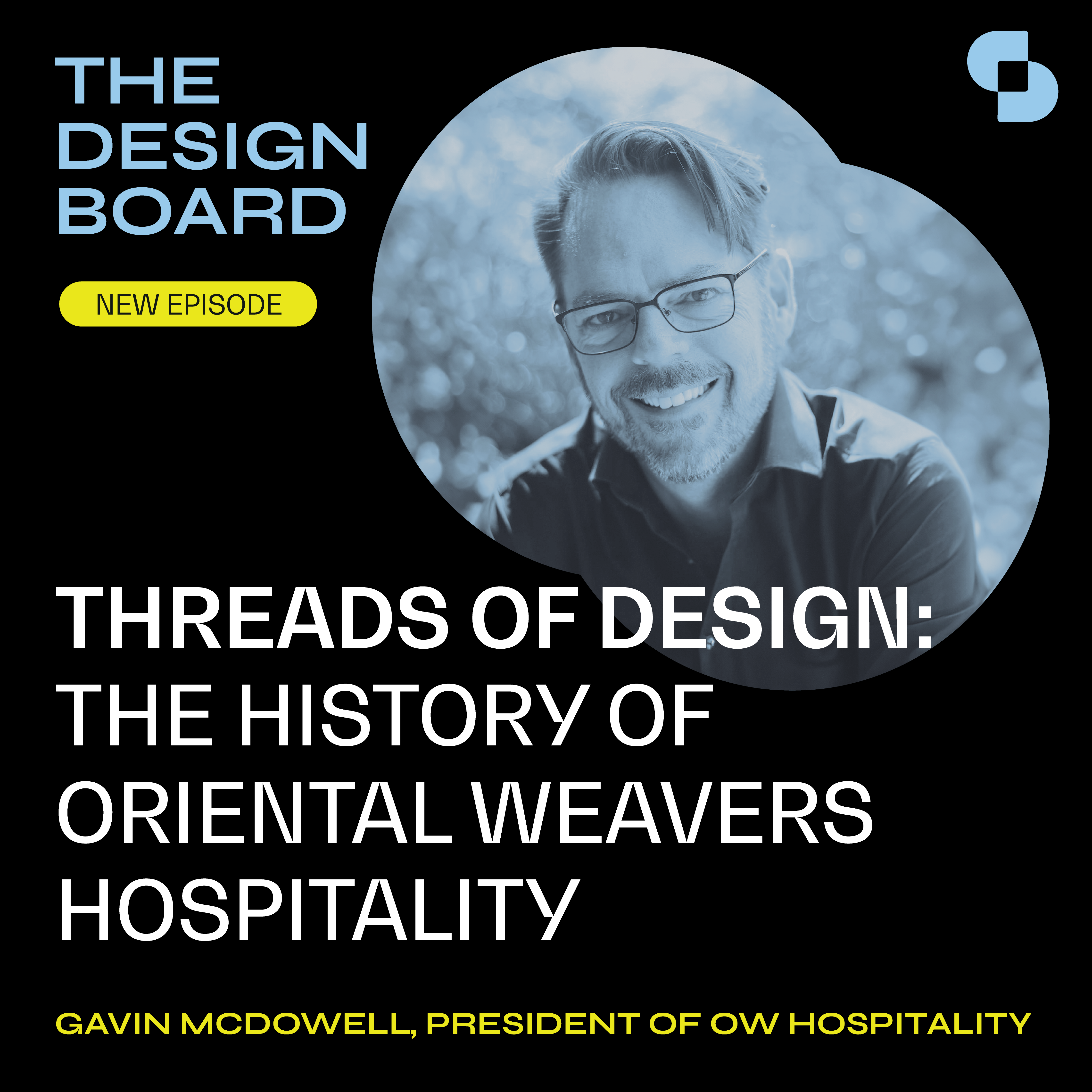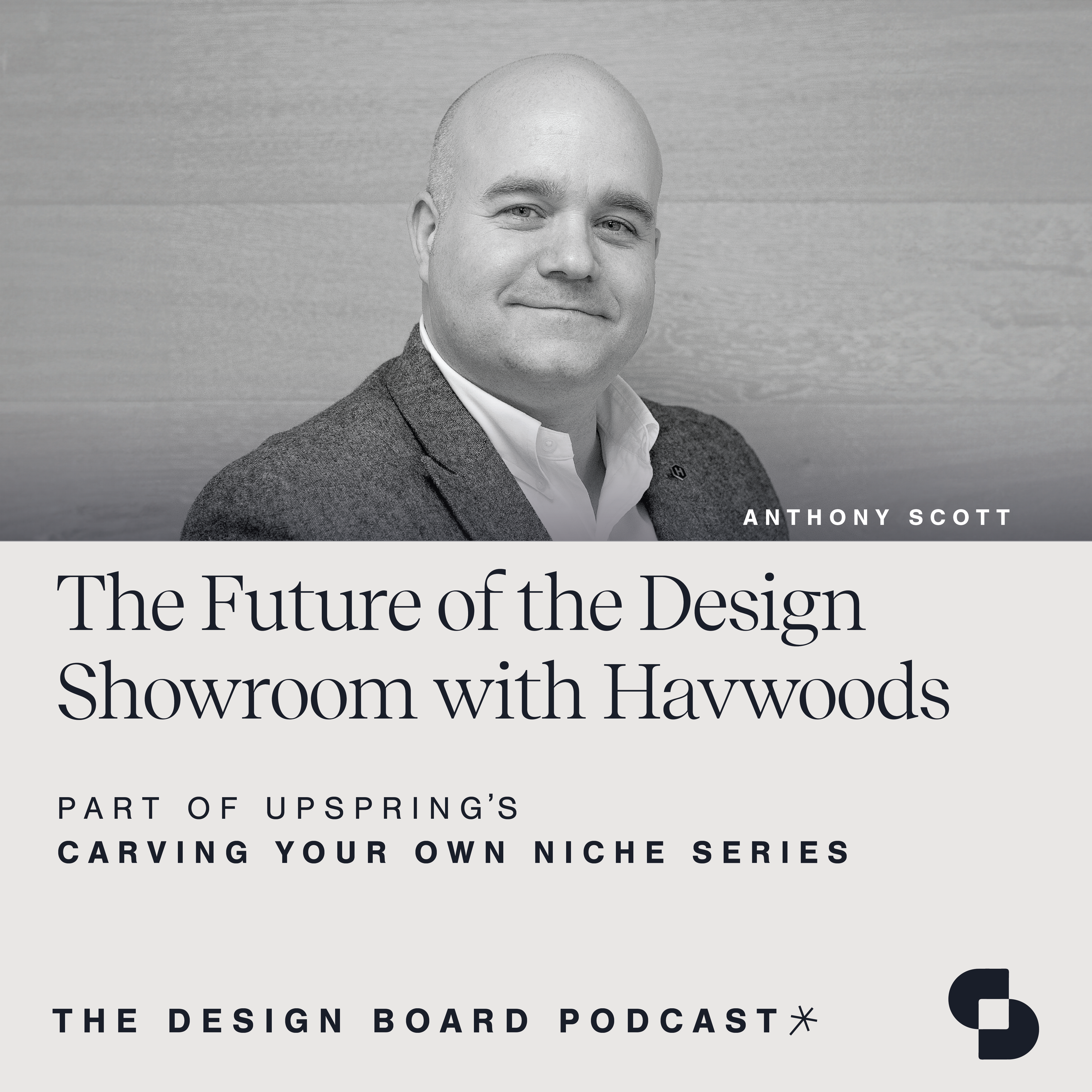In this episode of The Design Board, we sit down with architect John T. Campo Jr., who brings over thirty-nine years of professional experience to the table. John shares insights into the world of architecture, discussing the delicate balance between architectural creativity and business acumen. Drawing from his extensive knowledge in the development sector, we explore the challenges, rewards, and innovative approaches that have shaped his lengthy career.
The Design Board, by UpSpring, is a proud member of SANDOW Design Group’s SURROUND Podcast Network, home to the architecture and design industry’s premier shows.
Speaker 1:
Welcome to The Design Board, a podcast created by the team at UpSpring that focuses on design, development and everything in between. We invite innovators in our industry and explore topics that support your growth in every way. The Design Board is a proud member of Surround, a podcast network from Standout Design group featuring the architecture and design industry’s premier shows. Check it out at surroundpodcast.com.
Susan Fernandez:
Welcome everyone to The Design Board, a podcast by UpSpring that focuses on design, development and everything in between. We host innovators in our industry and explore topics that support your growth in every way. I’m your host Susan Fernandez, and today I’m so excited to be joined by John T. Campo Jr., president and founder of Campo Architecture and Interior Design. With over 39 years of professional experience and architectural licenses in over 20 states, John T. Campo Jr. has successfully managed a wide range of complex design and construction projects. His hands-on approach to project management and unyielding commitment to client service is reflected in the firm’s longstanding relationships with several prominent national leaders in the hospitality and healthcare industries. John is a nationally renowned historic tax credit expert, combining his architectural skills to create equity for his clients. Since its inception in 1985, Campo has been committed to design excellence. To meet the needs of the firm’s clients, they approach each project by developing innovative, cost-effective solutions, and delivering the highest quality architectural services on time and within budget. John, welcome to the show.
John T. Campo Jr.:
Thank you, Susan. It’s a pleasure to be with you today.
Susan Fernandez:
Oh my gosh, we are so excited to have you here. I think there are a million people who would love to know your secret to success.
John T. Campo Jr.:
Well, the secret, quite frankly, is to get up and go to work every day. That’s one of them. And I have a grandson that asked me that same question. He’s like, “What’s the secret?” And I said, “That’s one of them.” But I’ll give you a little background as to how this all started, because it was at a tender age of 15 when I knew I wanted to be an architect. And so that was the result of a mechanical drawing course that I took that was very intriguing. And so ended up attending the LSU School of Architecture, and in some cases, it was archi-torture because architecture school is not for the faint of heart. It’s very rigorous. But we learned so much that during that five-year program developed marketable skills that served me well when I got out into the job market.
So in 1980, I graduated and I started working in my internship in Atlanta. And it was a fairly large firm, and my first project with them was a Marriott Hotel in Biscayne Bay. And I bring that up because our company is most known for its hospitality work. Little did I know in 1980 that that’s where that was going to lead me. So in 1983, three years of internship, I got homesick and moved back to Louisiana, to New Orleans, and started my practice at the tender age of 26. I didn’t know any better, but it worked out. I was very fortunate. There were a lot of things that I was blessed with along the way, and one of them was my first significant project as a licensed architect in 1983, and it was the Jackson Brewery. And that project was in New Orleans at the foot of Jackson Square. It was a dilapidated, boarded-up, old historic brewery, and found myself with two college roommates and a fellow named Steve Bangler at Concordia Architects having the benefit of being awarded this commission.
So the oldest guy was 30 years old. This client took a big chance, but there was a big reward, and that is $14 million in construction budget that was fast tracked. And we delivered the project in 14 months for the opening of the World’s Fair in 1984. And so that was the beginning of what would be a career and a specialty in historic tax credit work. That project, what intrigued me, because up until then it was all new construction that I had been trained to design, this was far different. And historic work is significantly different. I learned about what a salmon brick was. A salmon brick was used in the interior wide of the historic walls because, in those days, the kilns didn’t fire the brick evenly, and the softer brick had a pink salmon-like glow to it, couldn’t withstand the harsh weather of the exterior skin. So they used it on the interior of the walls. The better brick were used on the outside.
And so that’s one of many examples of what really differentiates historic work from new. In New Orleans, we have this thing called the Mississippi River and the Mississippi mud. So buildings are built now on pilings, but in the turn of the century, these historic buildings, some of them up to 10 stories, the foundations were made out of cotton bales and mats of cross ties for railroads to spread the load of the building over the Mississippi mud because they didn’t have piling that they could drive back then. So again, this intrigue with historic work began at the onset of my career, and it has developed into a very highly specialized niche.
Susan Fernandez:
That’s really interesting. I don’t think that a lot of people fully understand the details of historic tax credits, and you’re an expert in this. So how does this compliment your architectural work?
John T. Campo Jr.:
Well, it actually now defines it. What we do is very highly specialized. There are a lot of very good architectural firms out there that can produce and do produce quality historic work. But where we differentiate ourselves, I use the term the synthesis of architecture, interior design, and historic tax credits. Now, what does that mean? Well, over the decades I’ve learned that all of these different areas of expertise really become one; they’re integrated. And the reason they’re integrated is in historic tax credit work, there are standards for rehabilitation that the National Historic Trust publishes that read like a building code. They are not; they’re far different. In fact, they’re interpreted from state to state very differently. But that synthesis that I’m talking about is being able to understand what those standards mean.
And then there are other areas that we call it the AHJs, the authorities having jurisdiction. Who is that? Permit office, the state fire marshal, the health department, they all have other codes that are specific to their discipline. So the NFPA 101, the International Building Code, the ADA, these are all codes that exist, and they have to co-exist with the standards. So I’m going a little bit into detail right now, Susan, but here’s the point. What we do is we analyze the historic building, and we have to understand what all these stakeholders want. In some cases, and in most cases, the State Historic Preservation Office joined with the National Park Service are looking at the project from a lens that says, “Okay, what are the character-defining elements that are historic in nature in this building that need to be retained?” And the exterior windows and doors and stairs are always sacred. That’s important.
So let’s just look at stairs. When these buildings were built, there weren’t any codes. So the stairs most often are narrower than the current codes. So understanding that as, okay, that stakeholder says those are character-defining elements. If you remove them, you get no tax credits. You got to retain them. That the opposite end of the spectrum would be the National Fire Protection Association, NFPA 101 that says you have to maintain a certain width for those stairs. And the magic is understanding all of the codes. And the letter with which it’s written is one set of information, but one has to specialize in understanding what’s the intent behind it, why did they write that section of the code? And with that knowledge, we’re able to create our own code and write equivalencies that give an equivalent degree of safety to what is actually specified by these authorities having jurisdiction. So we have to negotiate each and every one of these.
That’s the synthesis that we’re talking about. We’ve got historic tax credits and historic tax credit agencies with their set of requirements, and then all of the other agencies that we do an equivalency. How does one make a stair wider? Well, you really don’t. There are other things that you can do before you enter the stair to hold people in a two-hour rated enclosure, thus buying time. So the intent behind the stair being enclosed is you’re putting occupants in a setting where the building’s on fire and they’ve got two hours minimum to exit the building, and so we make the holding area bigger. This is one of many rabbits out of the hat that we have to pull. That’s an example of the synthesis that we’re talking about, one of many.
We take on projects that most others shy away from. They always have a lot of hair on them, but at the end of the day, they’re some of our most successful. There’s another component to this that we’ll touch on. Historic buildings are as green as any building. They’re greener because they’re already there. So we didn’t realize in the ’80s and the ’90s that our work was having a significant impact on reducing the carbon footprint. But as we know now, that is something that is a must. And so for four decades now, I look back at our body of work and it’s like that’s an awful lot of buildings that we were able to salvage where we didn’t have to go and have new materials manufactured. So there’s a lot of benefits that go with that, too.
Susan Fernandez:
I love that. I don’t think anyone talks about that. And it’s really quite incredible because we’ve done a number of podcasts talking about how building is responsible for 40% of carbon emissions. And to be able to look at that with the historic tax credit lens is really interesting. And I really am struck that you are almost creating your own codes, as you say, in this synthesis where you really do have to look at things and say, “We can keep these stairs.” It’s fascinating. And how does that change from state to state? Do you usually have to get in there and really understand, or is there a lot of variation, I guess is my question in these codes?
John T. Campo Jr.:
There is. I’ll answer it a couple different ways. One with respect to the NFPA 101, more so the international building code, each state, and actually each city will amend it. And one needs to understand that, again, the ABCs are just reading the books, reading the codes on their face. But we practice in 20 plus states, so we’ve learned long ago that when we are commissioned to do a project in a state we haven’t done business in before, first thing we do is we fly there and we meet with those code officials because we want to talk about what their interpretation is on certain aspects. We also want to know what portions of that code they’ve amended.
I’ll give you an example. For many years, Florida had its own ADA. It was more stringent than the rest of the country, than Michigan, more stringent. And the method to our madness is get informed. But let’s switch now to the standards for rehabilitation. In our practice, those interpretations vary wider than the other codes. It’s just the nature of the game. Each state has its own different department. It’s called SHPO, S-H-P-O, State Historic Preservation Office. And the way the standards are written can be interpreted much differently. Some folks that are the authorities having jurisdiction and SHPO, I’ll say, they have a mindset of restoration, which is different than other states; they vary. These projects are rehabilitations. They’re not restorations, per se. Why does that come up? Many times the character-defining elements of a historic building have been lost. They’re gone. There are portions that have either decayed, and so they’re lost forever. A restoration attitude means, okay, you need to do the research, understand what it looked like, and essentially recreate it.
We find that in much fewer states than those that understand this is a rehabilitation. In fact, in our design work, some areas where they have totally lost that character-defining element is, this is counterintuitive, Susan. The attitude is we don’t want a false recreation of history. We don’t want you to go back and literally go back and have molds cast where it’s exactly a replica. In fact, we want a clear demarcation in time of the architecture. Thus, a lot of the work that you see in our portfolio when you look at the interior and sometimes the exterior canopies, very contemporary. It’s a juxtaposition between old and new. And the theory there is that they want the public to be able to easily distinguish between the two, because buildings over their lifetime, they change.
Susan Fernandez:
Absolutely. And I feel that that is really influenced by European cities like London, where you really see that. I used to call it cutting edge higgledy piggledy. It really is this kind of beautiful where they will put a glass extension on an old building. And that contrast, that juxtaposition really makes the old even more precious or more powerful, and the new really brings it and makes it so you don’t feel like you’re being fooled.
John T. Campo Jr.:
Yeah.
Susan Fernandez:
So I love this already. We’re talking code interpretation, writing your own codes, figuring out ways around this and then this. So that’s all kind of science and math, like we’re not going to recreate these using new molds to try to look old. But there’s also such a sense of artistry involved. And as I look through your portfolio, the historic hotels really seem to exemplify this. So you guys have a passion for hospitality. Can you talk a little bit about that?
John T. Campo Jr.:
Oh God, yes. We’ve designed and continue to design many different building types, some utilitarians. We do industrial work. Most folks don’t know that about us, but I’ve done a number of industrial projects, medical, military, retail, but hospitality is different. It’s fun. It’s just a lot more… God, I need to be careful how I say this. It’s fun because the owners, the clients, they have in their budgets an extraordinary amount of money that goes beyond the utilitarian aspect of the project. You see, the guest experiences in hospitality continue to change. Guests are more sophisticated. They want to experience something different than the past, which is nothing wrong with new builds, but when they wake up in a hotel room, I think they want to be connected to the city that they’re in. And so there are budgets that are allowed, that are required really where the clients want design. They want creativity. They want storytelling so that the guest experience is enhanced.
Now, why is that? Well, one on its face, guests are just happier. They love the experience. The other is very financial. It’s proven. There’s data out there that guests are willing to pay more for that experience. Owners understand. While we design new buildings, we do, the historic nature of them and the hospitality that goes with it, the food and beverage, the entertainment, there’s so many different components to it, create an enhanced guest experience. They’re willing to pay more. It’s a win-win. They make more money on our projects than new builds most of the time. Again, I’m being very general, but guests are looking for something different.
Susan Fernandez:
Do you think it’s because you’re from New Orleans that you love hospitality? I think that’s such a fun hospitality city.
John T. Campo Jr.:
Oh, you bet. Yeah, absolutely. And I’ll tell you, the city of New Orleans has served my career very well. I didn’t realize it at first, probably the first 10 years of it. I’ll tell you how. We started doing out-of-state work shortly after my career started. 1987 was my first out-of-state Project. And the reason New Orleans served me well is you walk in and you say you’re from New Orleans, and it’s just immediate. People say, “Well…” They may not even speak it, but it’s just an immediate connection with hospitality, fun, history, outdoors, celebration, music. And so New Orleans, the city itself, God bless them, has served my company very well in that additional marketing edge that it created for us.
Susan Fernandez:
And you survived Katrina.
John T. Campo Jr.:
Yes, we did. It was horrible. It was. We survived it. I’ll talk about relationships as we go through life. What started out as our clients became our friends, and now we’ll get into real estate development later, they’re my partners. Hurricane Katrina happens. Everybody flees from the city. Half of my firm leaves and never comes back. Couldn’t blame them. Most of our folks that work for me are from out of state or some from out of the country. We end up fleeing to Dallas, Texas. We stay at the Embassy Suites at Market Center. My client that hired me to do my first hotel in 1987, still my client, 2023 still my friend, owns the hotel, puts us up. And three days later, we drive back home and can’t go to our office or my home. Got nowhere to go. We end up going to Baton Rouge. And the same client, they own over 200 hotels, they own the Embassy Suites right there near LSU on College Drive, and they had one room available, and they put my family up. Shortly thereafter, they made 10 rooms available. And what was left of my firm, we stayed there for three months, went and bought new computers, opened up our office in a conference room. And because we do mostly out of state work, we got back to work and we were making money again from that Embassy Suites hotel. The guy’s name is Tom Corcoran.
Susan Fernandez:
Wow, that’s incredible. So how long were you there and how did you make your transition back? Just curious.
John T. Campo Jr.:
Well, it was about three months and our home got utilities back, and so we were able to go back home. I’ll just say it like it is, the mayor at that time says, “The city’s fine. Everybody come back,” and not the case. We went back, and I’m glad we did. We were one of the first architectural firms back, but sprinkler systems didn’t work, and the streets, it was awful. But you know what? It’s behind us now. And instead of dwelling on that downside, I’m going to tell you a little bit about the silver lining. You never know. You never know what’s next. So what was next for us? We did military work pre-Katrina. Little did we know that, very quickly, the Louisiana Army National Guard would get $750 million appropriated to it from Congress, emergency funding. And so one of our clients there said, “Okay, we’re going to put out these RFPs,” and Campo Architects ends up with $80 million worth of work. It’s crazy, isn’t it?
Susan Fernandez:
Wow, yeah.
John T. Campo Jr.:
With half of a firm. So I had a new problem, and that is, okay, now I need more people. There was very short durations. We were able to hire people very quickly. We assembled a team and we designed the joint force headquarters, the [inaudible 00:21:48] general’s office, the dining facility, the BEQ, which is a hotel, Bachelor’s Enlisted Quarters at Jackson Barracks in New Orleans, and a readiness center in Bogalusa, Louisiana. So there was a silver lining, and that is… And that’s one of the things, Susan, I’ve learned about these events, the 9/11s, the Katrinas, the worldwide recession, there’s always a silver lining. You got to stay optimistic even when it’s horrible. And being an owner, you better be positive even when things are terrible, because character is defined under stress. When everything’s really good and people are making money and projects are flowing, everybody’s got character. No, characters defined under stress. That’s what owners know. Sorry, that got kind of heavy, didn’t it?
Susan Fernandez:
No, I love that. I absolutely believe that. I think, what do they say, hard times make strong people. So if I am a architect thinking about going out on my own right now, people would say, “It’s a recession,” or, “We’re in a semi recession.” But what advice would you give them? Stay tight or start?
John T. Campo Jr.:
I would always say start. It doesn’t matter if it’s good, bad or ugly. Look, I graduated in 1980 when interest rates were 18%. I started the business in 1983. Now, fortunately at that point, Reagan was president and the economy was starting a pretty good upswing right then. But if you have that passion to be an owner, then go for it. The sooner you jump in, the better. And that’s just my position. And right now, as hard as things are, there’s work out there. It’s harder to find, banks have kind of sewn up their pocketbooks along a lot of new construction, but it doesn’t mean that there’s not work out there. You just have to compete and work harder. The secret to success, get up and go to work every day.
Susan Fernandez:
Yeah, I think it is something that we have to be prepared for as owners that we are going to have challenges come up. I love the silver lining. I do think that getting up and going to work is excellent advice. So we’ve talked about the historic tax credits and hospitality, but you guys have a very diverse portfolio. You’ve done things like student housing, hospitals, you have referenced some of the military work, commercial sites. So how does this versatility allow you unique insights into various facets of architecture and design?
John T. Campo Jr.:
Yeah. That’s a good question. We also are master planners, and I say that because right now we’re in our, I think the end of our second year and doing the master plan of the historic riverfront of the city of Monroe. And this versatility, the experience of going through different building types, it opens a lot of doors, and it’s a catalyst for urban revitalization for communities. What we’ve learned about ourselves is, yes, we still design buildings, but what we’re really doing is we’re doing a significant change to historic urban centers, and Monroe is an example. So that versatility with the city of Monroe, we’ve identified many different historic buildings, most of which are vacant. A lot of them are vacant, not all of them, but we’ve had community engagement. In fact, this past weekend, our team was there and they had another really… It was well-attended where we engaged the community and the youth, children to come in. And we built a model of the entire historic city, a model, and they were able to create their own businesses and they would make their own model. And it was really a beautiful thing.
But some of them said, “I want to have a veterinary clinic. I want to have a snowball stand.” Well, this versatility that we have from experience of different building types lend themselves very well to master planning. The historic buildings, they are not occupancy-specific. Most folks don’t really realize that, but they can be a hotel, a retail facility, a grocery store, student housing, entertainment. What we’ve learned in Monroe is there are all of these needs, but they’ve been, over time, decentralized. They’re away from the center of what used to be downtown. Now, there are some restaurants and other facilities that are starting to migrate back, but our work is the catalyst for bringing those occupancies into historic buildings. St. Francis Hospital right there in Monroe, they have a nursing program and they have physicians that visit there for extended periods of time. So there’s a need right there for certain types of housing for those folks.
So I know I’m rambling a little bit, but that versatility is something that is serving us well in our master planning efforts. And the Monroe opportunity came about because of our project specific in Savannah, Georgia, which is the firm’s largest project and probably the most… It’s an internationally-renowned project. All in, it was $350 million. It changed the historic face of the Savannah riverfront forever. That facility, it’s an entertainment district that has a JW Hotel, but it’s actually three different hotels. It has 14 food and beverage establishments and an amphitheater, and it is a teaching facility. The centerpiece is the historic Georgia Pacific Power Generation Plant. And so the theory or the theme of it is the origin of power. And so there are from kindergarten all the way through high school tours and such where the environment itself lends itself to a teaching facility.
Susan Fernandez:
So this is really interesting. So the historic tax credits play a role even in master planning when you’re looking at that.
John T. Campo Jr.:
Absolutely. There is a list of endangered buildings every year that’s published that are historic. And our work, while it changes the dynamics of cities in many ways economically, but there’s another part of that, and that is these are historic treasures, and they use the term demolition by neglect. It’s a very kind term. It means rotting to the ground. And so the three-foot building in Meridian, Mississippi is a centerpiece. It’s a high-rise building. And that building was on the endangered list for about 20 years. And so this passion that I have for our work, it’s multifaceted, and part of it is in addition to the guest experience and the carbon footprint being reduced, is bringing new life into America’s historic structures that otherwise we would lose.
We have a client that invested $40 million in the city of Meridian, Mississippi on a 17-story building called the Three Foot Building. It’s a Marriott hotel, and it has changed the dynamics of that city. Now you see breweries, restaurants, corporations that were on the exterior of the city that have moved in and they’re inhabiting these buildings. Mississippi State University has satellite campuses and all. So there are many, many different pieces to our work, many different aspects, and one is saving America’s historic treasures.
Susan Fernandez:
Oh my gosh, I love that. I, just sidebar, am from Buffalo and, my God, we had beautiful architecture there. I would imagine you’ve done work there.
John T. Campo Jr.:
I have not, but I’ve been to Buffalo and it was like, what a target-rich environment that is. Yeah.
Susan Fernandez:
Incredible.
John T. Campo Jr.:
It is.
Susan Fernandez:
Incredible. If the folks in Buffalo don’t know about you, they should because they’re-
John T. Campo Jr.:
We would love to be there.
Susan Fernandez:
Oh my gosh. The buildings are absolutely gorgeous. Can you tell us about the most challenging or one of the most challenging projects you’ve ever worked on? What was the situation, and how did you solve it?
John T. Campo Jr.:
Okay, that’s a good one.
Susan Fernandez:
No pressure.
John T. Campo Jr.:
No pressure. This one is actually a very interesting one. It’s a much different building type, and it probably was the most challenging for us. And it wasn’t because of necessarily the building. It was the end user. This is in New Orleans on St. Charles Avenue. It’s the Women’s Center for Breast Reconstructive Surgery. And why was it challenging? I’ll start with the patients. These were women that had undergone surgeries for breast cancer around the world. The clientele was international, and they were botched up. It was horrible. And these surgeons that were in New Orleans, they developed a technique unlike any other where they could reconstruct and put these women physically and emotionally back together. It was very moving.
I learned an awful lot about the methodology and tattoo artists in the French Quarter that would come in and do some amazing things. And what it did was it restored them physically and emotionally. So having to get our team’s mindset into the end user was a bit heavy, but it was very gratifying, because let’s now talk about the physical structure. There were three buildings involved. One was an existing building that was a three-story office building. The middle building was the historic one, and then the third building was a Tasty Donuts facility that was not historic. So that was demolished, and we wove all three of them together. The historic building was a previous historic automobile dealership. Kind of funny, isn’t that?
Susan Fernandez:
Yeah, that’s challenging.
John T. Campo Jr.:
But it was also a benefit because it had a lot of natural light. It had large expansive glass and all. So being able to take an existing building, a historic building, and a new building and weave them together. Again, these are only three story buildings. So we’ve done much larger-scale work, but this was as challenging as anything we’ve ever done because, again, remember what we were talking about with the authorities having jurisdiction in the middle of this building? In the middle of these three is the historic structure. So we had to do all of these preservation things to it, and then tie into that the technical aspects of a hospital.
So the patient experience, it had to be spotlight. When you look at the interior of this building, you don’t know it’s a hospital. There’s water to soothe you. There’s a little fountain in the lobby. The lobby is three stories with natural light. The detail with which we approached this project with the interior designers, Chrestia Staub, that’s the name of the interiors firm, but they were part of this team and a very important part of this team. The details were all the way down to in recovery. When you’re laying on your back, the light fixtures, instead of being harsh, were stained-glass. So the light as you’re coming out of the fog, so to speak, these patients, it was a transition very slowly. And so this is one of those, it’s a one of a kind.
Susan Fernandez:
Oh, that’s really fascinating. And that does speak to how much healthcare takes cues from hospitality. I love being a guest rather than a patient. I think it’s the way it should go. So switching gears a bit, you’re in over 20 states, and we’ve talked a little bit about how you interpret those codes in some of the tax credits, but you’ve also mentioned that in hospitality there’s a real push towards local. So how do you reflect the regional design styles, the culture? How do you guys do that?
John T. Campo Jr.:
Well, it starts with the building that’s already there. It’s historic in nature, and it’s got a certain vocabulary and a character onto itself, generally the exterior skin. And so there’s an immersion there into the history of the building, but also an immersion into the history of the environment, the city. So we go in as a team. Our firm is, again, it’s very different. We have in-house architecture, interior design, historians, special tax credit legal counsel. We’re built for real estate development, which we’ll talk about in a minute. But the immersion starts with a deep dive into the history of the building itself and the city, understanding past, present, and future. And sometimes there isn’t much of a future, so we help create that vision with the powers that be. So I think that’s where it starts understanding from many different points of view. Sometimes it’s culinary, sometimes it’s entertainment, educational.
We like to get the input from local folks. A lot of the interior design will incorporate local artists in some instances. There’s a hotel company out there that I love. It’s called 21c, and that’s one of my favorite brands because they have art museums within the hotel. And so there’s this encouragement and this involvement of the community with the hotel or food and beverage. That’s another point to be made. We’ve got two projects right now that we are just about to start in St. Louis, and the food and beverage aspect, what we learned is these buildings are surrounded by high-rise buildings that are multifamily. And there’s some really good restaurants in St. Louis, not many downtown. There are some, but Italian food, there’s this place called The Hill. It’s like Little Italy to St. Louis, Sicilian heritage. So I found The Hill very quickly.
But the food and beverage design takes into account the guests, but just as importantly, the community. So the restaurant is there. In fact, we’re branding and promoting it to where there’s a marketing effort to get the message out to the community that this is going to be a fantastic restaurant for everybody to enjoy. In Dayton, Ohio, right now we’re doing a tapestry hotel, and our interior design group have done a fabulous job. It is a Florentine Steakhouse in downtown Dayton. So there’s the art, the culture, the food, the music where we want it to be integral with the community.
Susan Fernandez:
That is so insightful. I love that. Okay, so John, you mentioned earlier that you have started developing real estate. Can you tell us about that?
John T. Campo Jr.:
Sure, I’ll be happy to. It started in 1998, almost by accident. We were doing work in New Orleans, and it was the conversion of a high rise Radisson Hotel to an Embassy Suites in the warehouse district. This is a client, the same client that I told you about in Dallas, Texas, Tom Corcoran. They owned the Holiday Inn in the French Quarter and Chateau Lamoyne. And he was asking me, “John, if you can find me another hotel, we want more hotels in New Orleans.” So just to cut to the chase, there was a historic 10-story building right across the street next door to the project we were working on. And I walked by it every week to go do a site visit from my office, three blocks.
And this one day I walked past it and I look, and there’s a empty 10-story historic building. I’m looking up. The for sale sign had been on it so long that it faded, and I barely could see the telephone number. Short story is that was our first real estate development. It was a pre-sold hotel. We were the developer with our partners, Donahue Favret Contractors. We designed it. We built it. We delivered it on time, on budget. Client was very happy. So we sold the hotel the day after it was opened, a certificate of occupancy. So that really got me intrigued with something that I always dreamed about. And that is, I don’t mind, I quite enjoy making my clients wealthy. They work hard, they take the risk. And over the four decades, we’ve done that. But one of the things that architects do a fantastic job of is they work themselves out of a job every time you get a certificate of substantial completion. So you got to go find another one to keep the pipeline full.
In real estate development, while there are risks associated with it, the certificate of substantial completion ends the design work and the cashflow from it, but it’s the beginning of another cashflow. And that is, as a partner, if one is successful, then there’re financial rewards for that. So we’ve put together a team that, I guess for the last five years in earnest, we have really been at work with finding historic buildings. That’s a must. Our niche is historic, and the reason that it works is because historic tax credits offer a significant financial benefit that really levels the playing field. But I will tell you this, Susan, right now with the lending environment, there aren’t many games in town that are still working, but this one is. Why is that? What we do is there’s a methodology, and there are 36 participating states that have a matching state historic tax credit to the federal.
The federal historic tax credit is for 20%. It applies to all US states and US territories. Each state is different in the match. Many states like Louisiana, Texas, Missouri, Ohio, they have a 25% matching state program. So there’s 20 at the federal level, there’s 25 at the state, so that 45% in historic tax credits. What we do is navigate the arduous minefield of approvals. That’s the baseline. It positions the project to receive those tax credits, and we are able to essentially convert that 45% to cash with many mechanisms that we don’t have enough time today to talk about, but it ends up being about 30%. So there’s 30% of equity that our partners and I get the benefit of, and we will put upwards of 15% of our cash into the deal. So right there is 45% of equity that we have a position that costs us 15, and then the balances of it is senior debt.
And so right now, the senior debt we bifurcate where there is mezzanine debt through pace, which is a clean energy, that’s another incentive, clean energy program. New York has it, many states do. So the senior debt is about 45%, which makes lending not easy, but easier. When a lender is looking at 45% risk versus 60 or 70, particularly with what I’ve already described as a facility in a good market that has a guest experience willing to pay more. You see how all this all comes together? It’s actually a well-thought-out plan, one of the few I have in my life, but it is. So that has been the attraction to our clients over the past 40 years. And it’s hard. I tell my clients that the first time is, “Listen, you need to have the patience of Job. You cannot expect for this to be fast. It is not. And if that’s your expectation, then we should not work together.”
These approvals take 12 to 14 to 18 months. Now, they’re concurrent with the design activity and all of the other things, but Missouri would be a good example. That state is unique where there is a very competitive process where you apply and you have to get scored to be eligible for state historic tax credits. Very competitive. It takes about 14 months to get through that process. Louisiana, Texas, Georgia, Alabama don’t have that process. Ohio, same thing, same pain in Ohio. We love them because the gain is worth the pain. That 25% matching state tax credit is what makes these projects financially feasible. So we take the lead in real estate development. I have a lot of family involved in my business. My daughter is our director of marketing. One of my sons is our director of real estate development. My niece is the historian. So the goal there is really to mentor our company as well as our family, and it’s a lot of fun.
But we identify these buildings, our checklist is urban, vertical, large scale, historic tax matching states or states that have historic tax credits that match. That’s kind of the first array for site selection. And then in good markets for the building use, whether it’s multifamily or hospitality. It’s a lot of work. Our partners, as I said, generally we’re first our clients, then our friends, now they’re our partners. We always have a partner that is the contractor. Why? The single largest risk any developer takes once the deal is done is the construction risk. And as we know, sometimes architects and contractors have differences of opinion. It’s okay. But there is a vast difference whenever the architectural firm, interior design firm, all in one, tax credit, consultants still all in one is partnered with the contractor, a client that is the hotel manager, because our projects are large in scale, mostly $50, $60, $80, $100 million projects, very, very sophisticated. There’s always going to be unforeseen conditions. I don’t care how good you are, they’re going to be things that get missed. And when they do, instead of finger pointing, it’s problem solving time.
Susan Fernandez:
Yeah, that’s really great advice to bring that contractor in as a partner. They need to have skin in that game, for sure. John, you have so many specialties, but then you’ve been able to create a mix, a synergy that really brings so many of these specialties and unique insights to each project. And you seem to be always embracing what’s new in terms of how the market is behaving and how you can keep creating alongside your clients. For all those out there who are listening and thinking about their architecture career, how would you give them guidance?
John T. Campo Jr.:
Think big and think outside the box. And when you think you’re thinking big and outside the box, think again. And I’m saying it because architecture is a noble profession, but there’s a lot of work being done out there that I call commodity based. And look, the profession is difficult and challenging enough, but there’s some work out there that quite frankly just isn’t financially rewarding enough to take. Learning how to say no is very important, but thinking big and outside the box means trying to create a niche. You have to have a baseline as an architect, which is technical competence. You have to master the codes. You have to understand construction, budgets, but look at different building types. And my advice would be to try and find not just one niche because we’re multifaceted, but trying to find something that is a niche.
But remember that word passion? If you can’t be passionate about it, just don’t do it because it’s not going to work out very well. So number one is if you have the passion, okay, that’s numero uno. If you don’t, there’s absolutely nothing wrong with being a very good architect as an employee, because the reality is it’s a risk reward thing, and most employees do it because they love the profession, but it’s safe. There’s not much risk in it. For those of us that want to venture out and be owners, there’s a lot of risks involved with it. And that passion, that positive energy, that silver lining we’re talking about, if you had that, then go for it. You have to be proactive. The real estate development… I do speaking engagements occasionally. Sometimes it’s two young students at Tulane University or sometimes it’s at the Boutique Lodging Conference, but real estate development to me is a natural evolution of an architect. John Portman, have you ever heard of John Portman?
Susan Fernandez:
I have not.
John T. Campo Jr.:
Oh, he’s my hero. John passed about three or four years ago. Based in Atlanta, his son is running the company. I interned in Atlanta, and I met him there. This man created an incredible architectural firm, but more importantly, an incredibly international real estate development company. And I watched him over the decades. He went from being the guy that designed great buildings to the guy that was owning or partnering, and he didn’t know it, but he was my mentor. And so my advice to young professionals, architects, interior designers, contractors, is as you’re growing and learning and mastering your craft, take a look at real estate. I have people in my firm that I mentor that are partners and employees.
I’ll give you an example. One young lady she just developed in the French Quarter, a multifamily project. It’s one historic home. She got historic tax credits. She lives in one part of the home, and she’s going to be renting out the rest of it, creating positive cash flow. The next step is to do another one. And then eventually as the scale grows and there are partners that you create relationships with, typically they’re a client, then there’s this evolution in scale. And I say it because it is different. Most architects, when I’ve given these presentations, they’ll raise their hand and say, “John, man, that sounds mighty risky.” And my retort is, “Brother, you get up every day and take on as much or more risk as an architect than you do a real estate developer.” Susan, why am I saying that?
Do you know that across the country, there are statutes for architects where you can have a claim up to 10 years after that building is open. Now there’s a recognition over time that that’s just unreasonable. And so talking about risk, now, most states have pared it down to five years, some three because they’re understanding, look, the life cycle of a building, if something really is going to go wrong as a design or construction defect, it’ll manifest itself in 12 to 18 months. It’s going to go through the climate, the four seasons where there’s expansion and contraction and soil movement and weather, moisture migration. But in terms of risk, I think architects, when you look at the risk reward relationships, there’s no comparison. The upside for real estate development eclipses, I think, the risk that’s taken versus what an architect or design professional takes every day they get up and go to work.
Susan Fernandez:
Those are wise words. I love that. Is there anything else I haven’t asked you that-
John T. Campo Jr.:
Pro bono work. Pro bono work is something that is admirable, it’s desirable. I’m going to say this for my brethren out there and the young folks, it doesn’t mean that you should do work for free. There are too many folks out there that have been conditioned, and I call them strip miners, pardon me with the ugly phrase, but they’ll come at you and they will ask for everything in the world. And there you are doing all of this work. And generally, that’s strip minor is going to take all of that information and you might get an RFP to bid on the job after he’s taken advantage of you. I detest it. And so as a result, our firm, we do pro bono work, we do it, but it’s our choice as a business owner. Now, I’ve got the architecture hat off and the business mind on.
You don’t go to the physician or an attorney and expect them to give you treatment or advice, and you might hire them. No, that’s not the case. Architect shouldn’t be any different. And so it’s a litmus test and it’s called a retainer. And if one presents a retainer to a potential client, and it has to be reasonable, but let’s face it, we’re extended credit. We’re doing the work. 30 days later, we’re building the work. 30 to 60 to 90 days later, we’re getting paid. So we’re extending credit. While the retainer is a litmus test, and if that potential client gives you any pushback on the retainer, don’t do the project because it’s a sign. That’s a sign of things to come. If you think it’s going to be hard getting paid and they’re not willing to do the retainer, then there is a sign right there. And that’s when you say no. And I don’t know why it’s in this profession. I do know why. I take it back. We want to please, we want to serve our clients well. We want to go the distance. It’s unfortunate that there are folks out there that will take advantage of you.
Susan Fernandez:
That is worth its weight in gold. Great advice. This has been absolutely inspiring. Thank you, John, so much for your time today.
John T. Campo Jr.:
You’re welcome. It was a pleasure being here with you. Susan.
Speaker 1:
Thank you so much for listening in with us today. We hope you leave inspired by the ideas in today’s episode. For more, follow UpSpring on LinkedIn and Instagram. And don’t forget to check out the amazing lineup of shows brought to you by the Surround Podcast Network at surroundpodcasts.com.


